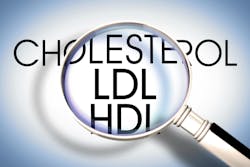New National Institute of Health (NIH) research reveals how "bad" cholesterol, known as low-density lipoprotein-cholesterol or LDL-C, builds up in the body.
According to a release, the study showed “for the first time how the main structural protein of LDL binds to its receptor – a process that starts the clearing of LDL from the blood – and what happens when that process gets impaired.”
The findings were published in Nature.
The researchers used an advanced imaging technique called cryo-electron microscopy. They “were able to see the entirety of the structural protein of LDL when it bound to LDLR. Then, with artificial intelligence-driven protein prediction software, they were able to model the structure and locate the known genetic mutations that result in increased LDL. The developers of the software, who were not involved in the study, were recently awarded the 2024 Nobel Prize in Chemistry.”
They “found that many of the mutations that mapped to the location where LDL and LDLR connected, were associated with an inherited condition called familial hypercholesterolemia (FH). FH is marked by defects in how the body uptakes LDL into its cells, and people with it have extremely high levels of LDL and can have heart attacks at a very young age. They found that FH-associated variants tended to cluster in particular regions on LDL.”

